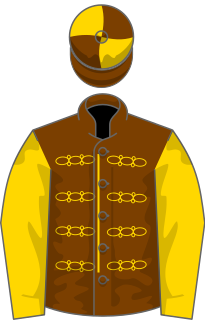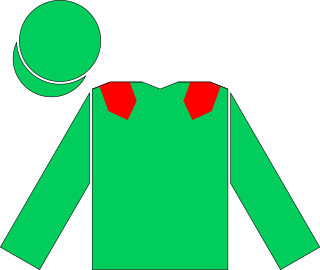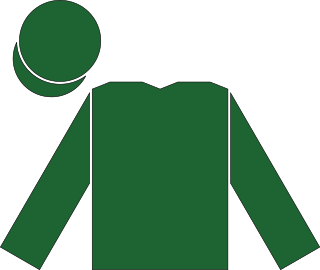Related Research Articles

Teenoso was an American-bred British-trained Thoroughbred racehorse. After showing moderate form as a two-year-old he improved in the spring of 1983 to win the Group Three Lingfield Derby Trial and then won the Classic Epsom Derby, giving Lester Piggott a record ninth win in the race. Teenoso was beaten in his two remaining races that year but showed his best form as a four-year-old, winning the Ormonde Stakes, the Grand Prix de Saint-Cloud and, on his final appearance, the King George VI and Queen Elizabeth Stakes. He proved to be a disappointment at stud.

Sinndar was an Irish Thoroughbred racehorse and sire. In a racing career that lasted from September 1999 until October 2000, he ran eight times and won seven races. He was notable for his unique achievement in winning The Derby, Irish Derby Stakes and Prix de l'Arc de Triomphe in the same year.

Generous was an Irish-bred, British-trained Thoroughbred racehorse who in 1991 won both the Epsom and the Irish Derby. As a two-year-old he won three of his six races, most notably the Dewhurst Stakes as a 50/1 outsider. He finished fourth in the 2000 Guineas on his three-year-old debut, but showed vastly improved form when moved up to longer distances in summer. In a period of seven weeks he won the Derby by five lengths, the Irish Derby by three lengths and the King George VI and Queen Elizabeth Stakes by a record seven lengths. His performances established him as one of the outstanding British racehorses of his era. After running poorly in the Prix de l'Arc de Triomphe he was retired to stud, where his record was disappointing.

Carroll House was an Irish-bred, British-trained Thoroughbred racehorse and sire. In a racing career which lasted from September 1987 until July 1990 he raced twenty times in six countries and won seven races. His most important win came in October 1989 when he won the Prix de l'Arc de Triomphe in Paris. His other wins included the Phoenix Champion Stakes, Grosser Preis von Baden, Princess of Wales's Stakes, Furstenberg Rennen and Welsh Derby. At the end of his racing career he was retired to become a breeding stallion in Japan and Ireland but had little success as a sire of winners.
Law Society was an American-bred, Irish-trained Thoroughbred racehorse and sire. In a racing career which lasted from August 1984 until July 1985 he won five of his eight races and was rated among the best of his generation in Europe in both years. As a two-year-old he won the Anglesey Stakes and the National Stakes in Ireland before being narrowly defeated in the Dewhurst Stakes. In the following year he won the Chester Vase and finished second in The Derby before recording his biggest win when defeating a strong international field in the Irish Derby. He was retired from racing at the end of his three-year-old season and stood as a breeding stallion in Ireland and Germany with some success. Law Society died in 2011 at the age of twenty-nine.
Tap On Wood was an Irish-bred British-trained Thoroughbred racehorse and sire best known for winning the classic 2000 Guineas in 1979. As a two-year-old in 1978 he won seven of his thirteen races including the National Stakes. In the following spring he defeated the outstanding miler Kris to record an upset victory in the Guineas. His later career was disrupted by illness and he appeared in only two more races, finishing unplaced in the Derby and winning the Kiveton Park Stakes. He subsequently had some success as a breeding stallion in Europe and Japan.

Northern Baby was a Canadian-bred, French-trained Thoroughbred racehorse and sire. In a racing career which lasted from October 1978 until September 1980 he won five of his seventeen races. After showing promising form as a two-year-old he emerged as a top-class middle-distance performer in 1979, winning the Prix de la Côte Normande in France but showing his best form in England, where he finished third in both The Derby and the Eclipse Stakes before recording his most important victory in the Champion Stakes. He remained in training as a four-year-old with mixed success, running several moderate races but defeating the outstanding filly Three Troikas in the Prix Dollar. He was retired to stud and became a very successful sire of steeplechasers. He died in 2007 at the advanced age of thirty-one.
Sir Harry Lewis was an American-bred Thoroughbred racehorse and sire best known for his win in the 1987 Irish Derby. After finishing second on his only appearance as a two-year-old he won his first two races in 1987 including the Dee Stakes. He finished fourth in The Derby before winning the Irish equivalent, which was then the most valuable race for three-year-olds ever run in Europe. Later that year he was placed in both the Matchmaker International and the Rothman' International. He ran twice in Europe as a four-year-old before being transferred to the United States where he had limited success. Sir Harry Lewis made little impact as a breeding stallion in North America, but made his mark as a sire of jumpers in Europe. He died in 2009.
Malacate was an American-bred, French-trained Thoroughbred racehorse and sire. He showed some promise as a two-year-old in 1975, before emerging as one of the leading colts of his generation in Europe in the following year. His performances in 1976 included wins in the Prix La Force, Irish Derby and the first running of the Joe McGrath Memorial Stakes, in addition to running well in races such as the Prix du Jockey Club, King George VI and Queen Elizabeth Stakes and Champion Stakes. After failing in his first season at stud he returned to racing in 1977 and won the Prix Foy. He was then retired for a second time and had some success as a sire or winners in Japan.
Sanglamore was an American-bred, British-trained Thoroughbred racehorse and sire. In a racing career disrupted by injury, he won four of his eight races between November 1989 and July 1991. After finishing second in his only race as a juvenile in 1989, he emerged as one of the leading colts of his generation in the first half of the following year, winning the Dante Stakes in England and the Prix du Jockey Club in France. After a lengthy break, he returned as a four-year-old to win the Prix d'Ispahan and place in both the Eclipse Stakes and the King George VI & Queen Elizabeth Stakes. He was retired to stud at the end of the year but made little impact as a breeding stallion.
Hernando was a French Thoroughbred racehorse and sire. He established himself as one of the best European colts of his generation in 1993 by winning the Prix Lupin, Prix du Jockey Club and Prix Niel and finishing second in the Irish Derby. As a four-year-old he won the Prix Gontaut-Biron and finished a close second in the Prix de l'Arc de Triomphe. In 1995 he won a second Prix Gontaut-Biron and was placed in both the Turf Classic Invitational and the Japan Cup. After his retireement from racing he became a very successful breeding stallion in England. He died in February 2013.

Jack Hobbs is a British Thoroughbred racehorse. After winning his only race as a juvenile, he established himself as a potentially top-class colt with a twelve length win in a race at Sandown on his three-year-old debut. He finished second to his stable companion Golden Horn in both the Dante Stakes and The Derby before winning the Irish Derby by five lengths. He ran twice more in 2015, winning the September Stakes before being beaten when favourite for the Champion Stakes. His 2016 season was badly disrupted by injury and he ran only twice, failing to complete his first start and being beaten on his eventual reappearance. However, he rebounded in 2017 by winning the Sheema Classic at Meydan Racecourse on Dubai World Cup Night.
Lake Coniston was an Irish-bred, British-trained Thoroughbred racehorse and sire. After being sold as a yearling for 22,000 guineas he was sent to be trained in England by Geoff Lewis. Unraced as a juvenile, he established himself as a top-class sprinter as a three-year-old with wins in the Hackwood Stakes, Prix de Meautry and Diadem Stakes. He was even better at four, winning the Abernant Stakes, Duke of York Stakes and July Cup. His performance in the last-named race saw him regarded as one of the best British sprinters of modern times. He stood as a breeding stallion in Ireland, England, Australia, New Zealand, Italy and South Africa with limited success. He died in South Africa in 2014 at the age of 23.

Owington was a British Thoroughbred racehorse and sire. He showed very good form as a juvenile, winning the Moët & Chandon Rennen in Germany and finishing a close second in the Middle Park Stakes. In the following season he was one of the leading sprinters in Europe, recording victories in the Duke of York Stakes, Cork and Orrery Stakes and July Cup. He remained in training in 1995 and ran well without winning. He was retired to stud in 1996 but died later that year.
Handsome Sailor was a British Thoroughbred racehorse and sire. A specialist sprinter, he showed useful, but unremarkable form in his first two seasons, winning three of his nine starts as a juvenile and two from four in an abbreviated three-year-old campaign. He emerged as a top-class performer in 1987, winning the Duke of York Stakes in England and the Prix de Ris-Orangis in France. He was even better as a five-year-old, winning a second Duke of York Stakes and adding victories in the Temple Stakes, William Hill Sprint Championship and Prix de l'Abbaye. His form was less impressive in 1989 but ended his racing career with a victory in the Flying Five. He was not a success as a breeding stallion and died in 1997 at the age of fourteen.
Emmson was an Irish-bred British-trained Thoroughbred racehorse and sire. He was one of the best staying two-year-olds in Britain in 1987 when he won four of his five races including the Washington Singer Stakes and the William Hill Futurity. He failed to win as a three-year-old but did finish third in the Prix du Jockey Club and ran prominently in the Prix de l'Arc de Triomphe. He remained in training for two more seasons, recording his only subsequent win in the 1989 Prix Gontaut-Biron. After his retirement from racing he had some success as a sire of winners in Brazil.

Galileo Gold is a British Thoroughbred racehorse. As a two-year-old he won the Vintage Stakes and finished third in the Prix Jean-Luc Lagardère. On his three-year-old debut he won the classic 2000 Guineas and went on to finish second in the Irish 2,000 Guineas before winning the St James's Palace Stakes.
Shady Heights was a British Thoroughbred racehorse. In four seasons on the racecourse he competed in Britain, Ireland, France, Germany, Japan and the United States, winning seven of his twenty-nine contests.
Wassl was a British Thoroughbred racehorse and sire. As a two-year-old he showed great promise when winning on his debut but missed the rest of the season through injury. In the following spring he won the Greenham Stakes and then rebounded from a poor run in the 2000 Guineas to win the Irish 2000 Guineas. He failed to win again in 1983 but was placed in the Sussex Stakes, Prix du Moulin and Joe McGrath Memorial Stakes. He dead-heated for first place in the Lockinge Stakes on his first run of 1984 but was well beaten in his four other races as a four-year-old. After his retirement from racing he stood as a breeding stallion in Ireland and Japan and had limited success as a sire of winners.
Strategic Choice was an American-bred, British-trained Thoroughbred racehorse and stallion. In a racing career which lasted from April 1994 until July 2000 he competed in nine different countries - Britain, France, Italy, Germany, Ireland, Japan, Turkey, Canada and Hong Kong - and won six of his thirty-four races. Unraced as a two-year-old he won the John Porter Stakes and Irish St Leger at four, the Gran Premio di Milano and Grand Prix de Deauville at five and the Bosphorus Trophy at six. He was also placed in the King George VI and Queen Elizabeth Stakes, Gran Premio del Jockey Club, Yorkshire Cup and St Simon Stakes. After his retirement from racing he had some success as a sire of National Hunt racing.
References
- 1 2 "Holding Court pedigree". Equineline. Retrieved 2015-01-30.
- ↑ "Hernando – Stud Record". Racing Post.
- ↑ Timeform staff (1987). Racehorses of 1986. Timeform. ISBN 0-900599-44-8.
- ↑ Timeform staff (1988). Racehorses of 1987. Timeform. ISBN 0-900599-46-4.
- 1 2 "Grand Duchess – Family 22-d". Thoroughbred Bloodlines.
- ↑ "Good ideas pay with Love Song". Racing Post. 6 June 2000.
- ↑ "Tomba – Record By Race Type". Racing Post.
- ↑ "Punch Retail Budget Beaters Conditions Stakes result". Racing Post. 13 October 1999.
- ↑ "Tomba moved from Meehan to Jarvis". Racing Post. 1 April 2000.
- ↑ "Haydock Park Sponsorship Club Rated Stakes result". Racing Post. 22 April 2000.
- ↑ "Prix La Force result". Racing Post. 18 May 2000.
- ↑ "Prix du Jockey Club result". Racing Post. 4 June 2000.
- ↑ "French Derby: Sensational!; Rivals left gasping as Holding Court's French Derby blitz puts Jarvis and Robinson back on the glory trail". Racing Post. 5 June 2000.
- ↑ "Interview – Philip Robinson: Robinson holds court". Racing Post. 30 June 2000.
- ↑ "Prix du Conseil de Paris result". Racing Post. 15 October 2000.
- ↑ "Longchamp: Jarvis mystified by Holding Court flop". Racing Post. 16 October 2000.
- ↑ "Grand Prix de Deauville result". Racing Post. 26 August 2001.
- ↑ Bill Barber (17 October 2001). "Holding Court sold to Saudi Arabia". Racing Post.
- ↑ "Holding Court – Statistics". Equibase.